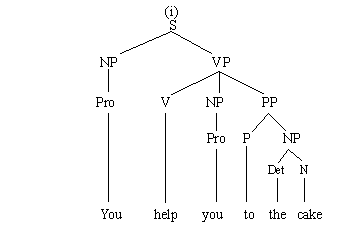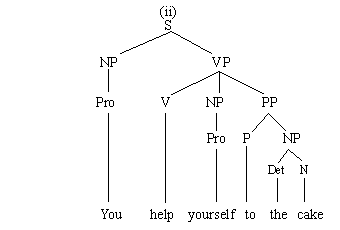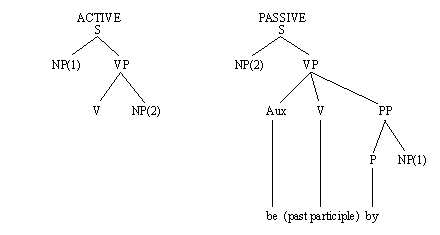As mentioned in 5.2, sentence relatedness is part of speakers' syntactic knowledge. Chomsky attempts to account for this aspect of syntax by postulating that there are deep structures and surface structures. Deep structures are the basic structures generated by phrase structure rules. Surface structures are derived structures, the structures of sentences that we actually speak. Surface structures are derived from deep structures via transformations.
One of the linguistic phenomena that give rise to the above postulation is discontinuous constituents. Consider (37) and (38):
(37) John turned the machine off.
(38) John turned off the machine.
Sentences like these challenged the effectiveness of immediate constituent analysis adopted in structural grammar. Native speakers of English all know that the two sentences are related and that turn and off are one constituent of the verb phrase. TG grammarians call the constituent turn and off in (37) a discontinuous constituent. The two sentences are generated by one phrase structure rule rather than two. (37) is derived from (38) by transformation. The word off is a verbal particle. It can be moved according to a transformational rule called particle movement transformation:
If the verb is followed by verbal particle followed by a noun phrase, the particle can be moved to the right of the noun phrase.
Particle movement transformation is a simple transformation which involves reordering of constituents. In addition, replacement, insertion, deletion and copying are also frequently used transformational operations.
In deriving the surface structure of Help yourself to the cake,
two transformational rules have been applied. The phrase structure rule
can generate the deep structure:

In English, there is a reflexivization rule which goes:
If there are identical NPs in the same sentence that refer to the same object or individual, replace the second with its corresponding personal reflexive pronoun.
Applying this rule, we get the underlying structure (a structure which is the result of transformation and in which further transformation will take place).

In English, the subject NP of an imperative sentence can be deleted. Applying
this rule, we get the surface structure:

When we turn an active sentence into a passive sentence, we do it by way
of reordering, replacement and insertion. First,
switch the position of the NPs. Second, replace the verb with the auxiliary
be plus the past participle of the verb (with be agreeing
with the preceding NP in number and with the original verb in tense).
Third, insert the preposition by to the left of the NP following
the past participle. The result of the transformations can be shown by
the tree diagrams:

When we turn a declarative sentence into a tag question, copying
is first used. Consider the following declarative sentences:
(39) He is not at home.
(40) They are not working.
(41) She has two brothers.
(42) We have enough time.
Turning these sentences into tag questions we must first copy the verb be or have or the auxiliary verb to the right of the sentence, make it negative if affirmative, and vice versa. Then we copy the subject NP to the right of the copied verb. Finally, we add a question mark. Here are the tag questions transformed from the declarative sentences:
(43) He is not at home, is he?
(44) They are not working, are they?
(45) She has two brothers, hasn't she?
(46) We have enough time, haven't we?
The transformations are much more complicated if more data are given. Our purpose here is simply to illustrate copying as a transformational operation. The formulation of transformational rules is a process of hypothesis formulation, testing, and reformulation. Given the following sentences, we have to revise our generalization about how to turn declarative sentences into tag questions:
(47) The boy is not at home.
(48) The girl who is singing has two brothers.
We have to revise the statement concerning the copying of verbs and the subject NP like this:
Copy the verb be or have or auxiliary of the sentences or that of the main sentence if there are embedded sentences. Copy the subject NP to the right of the copied verb and replace it with its corresponding personal pronoun if the head of the NP is a noun.
This statement is actually still not adequate, as it cannot account for the transformation of the following sentences into tag questions:
(49) The boy studies Chinese.
(50) The boy has been sleeping the whole day.
Our revised statement falls short because in (49), there is no auxiliary
verb, and the verb is neither be nor have, and in (50)
there are two auxiliary verbs. The statement needs to be further revised
to account for the data. Due to the limit of space we will not go on to
revise the statement. What is meant here is to show that generalization
of transformational rules is an ongoing process of theorizing. If transformations
do exist as a mental process there must be rules governing it. Transformational
generative grammar is a theoretical grammar (not a pedagogic grammar)
which attempts to account for this aspect of speakers' knowledge of construction.
It is therefore psychological in nature, as made clear by Chomsky (1965).